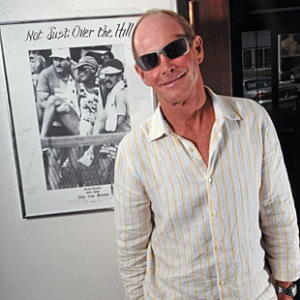
Lava Magazine's launch will be announced imminently. It's the new print publication from Ironman, with a masthead familiar to readers of Triathlete Magazine, heretofore the leading print periodical in triathlon for a quarter-century.
There should be no doubt: The Battle is Joined. Do not for a minute place stock in the high-road comments you may read. The Game is Afoot. Two Men Enter, One Man Leaves. We're about to witness twenty-four months of Tri Mag: Blood and Sand.
There were only ever two options: Ironman would buy Competitor Group; or, the two behemoths would find their ways into each others' businesses and ram heads like a pair of bull elks. And that's as it should be. May the best private equity company win.
Here's my concern. These private equity firms—Falconhead Capital and Providence Equity Partners—have purchased our sport's cultural institutions. One owns the most important print publications in American cycling and triathlon. The other, run by president Ben Fertic (pictured) owns the World's premier multisport event brands. The publisher is getting into event production; the event producer is getting into publishing. How will these cultural institutions be used during the donnybrook certain to come?
In part, I think we'll find out in Kona.
What I hope I do not read or hear is that the course in the Ironman Triathlon World Championship—always wide enough for Triathlete Magazine's photographers and editorial writers in the past—has suddenly grown narrower. Ironman needs to erect an absolute wall between its divisions. Blair LaHaye, Ironman's Director of Communications and the eminently capable husbander of its message, should stand fast and treat Lava Magazine like one of the many magazines eager to cover her company's race. Lava Magazine's press access should equal that granted Triathlete Magazine.
I write this for two reasons. First, we don't know how good a brand builder Lava Magazine publisher John Duke is, but, I have a hunch he was very good at it. I think a lot of people are going to be surprised at just how strong his (former) Triathlete Magazine brand remains, and what sort of momentum and vitality it demonstrates.
Second, Ironman should not end up like one of those isolated brands, the self-drawn circumscription of which limits its own growth. For most of the past two decades non-licensors were forbidden almost to breathe on the Big Island during Ironman week, when they should have been given VIP passes and feted at every banquet. This, because there are only two kinds of companies: licensees, and potential licensees. But the posture of WTC has been historically quite exclusive, not very inclusive, and although that stand-offishness has loosened under Fertic's capable management, the posture of exclusivity in many ways continues.
Ironman is now an activity that has its own pros, granted status only through Ironman's own licensing program, racing under its own rules, tested through its own drug testing program. Believe me, I understand why, in each case, Ironman has gone this route. But now it's about to launch its own print magazine, and, what it can't afford to do is let further divergence from the world of triathlon turn into isolation from the world of triathlon.
Ironman needs to remain a brand, and not become a cult. Lava Magazine represents a pivot point; we'll see in which direction Ironman decides to track.
I write all this only because I asked this question—will Triathlete Magazine be given the same press and photo access on the course that it enjoyed last year?—and I do not yet have an unequivocal answer.
When I see TJ Murphy, Triathlete's editorial director, and a Tri Mag photog, out on the Kona course, I'll know that Ironman has chosen the wiser route of inclusion.


